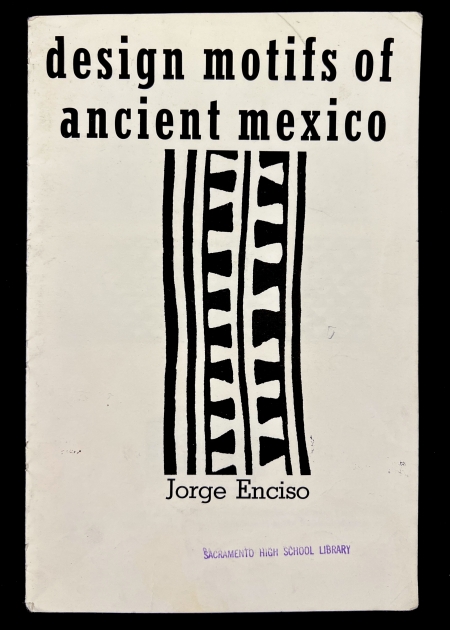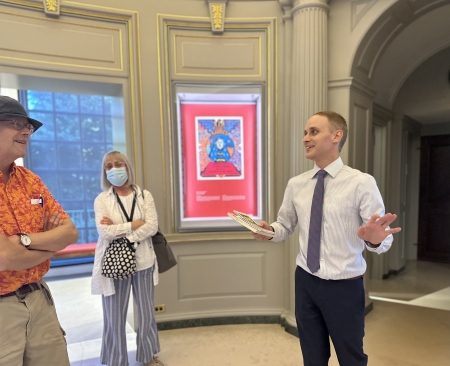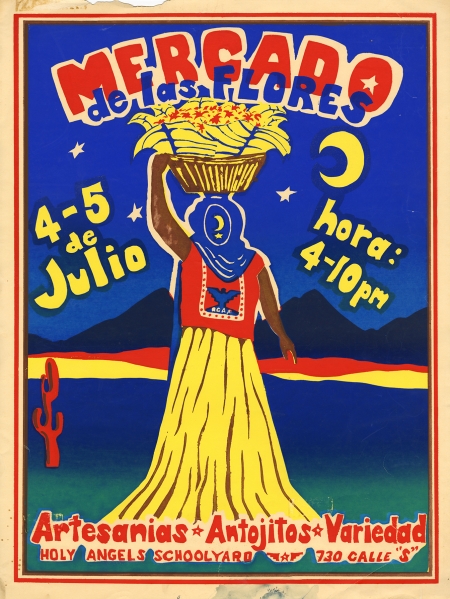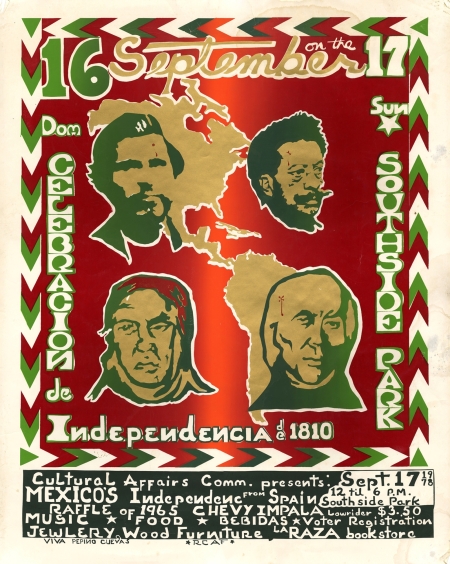Tess Kelley, Harvard College ’23, details what she learned from a curatorial talk about the “Royal Chicano Air Force” poster exhibition at Houghton Library.
There’s a book in Houghton Library that, even as it sits on Harvard’s shelves, has technically been “missing” for years.
That is because it was checked out of the Sacramento High School Library decades ago by a member of the Royal Chicano Air Force (RCAF), a Sacramento-based Chicano artist collective formed in 1970. Artists in the collective, who were of Mexican-American heritage, incorporated many Aztec designs in the book, Design Motifs of Ancient Mexico, into their artwork. When the book was finally returned to library shelves, it was many years later and thousands of miles away.

This book, as well as a large number of posters and ephemera, were acquired by the Harvard Library in May 2022 from David and Melinda Rasul. A member of the RCAF since the early 1970s, David Rasul served on the collective’s Cultural Affairs council, the RCAF branch that organized community services and programming. While RCAF art is present in university archives on the West Coast, Harvard’s acquisition brought the collective to the opposite end of the country.
At a recent curatorial chat in Houghton Library, Associate Curator of the Harvard Theatre Collection Dale Stinchcomb guided visitors through the exhibit of posters made by the RCAF currently displayed in the library’s lobby. Visitors to Houghton’s first fully bilingual exhibit were greeted by bold designs and even bolder colors — often thanks to the use of DayGlo paint.
As exhibit curator, Stinchcomb provided background on each of the posters, drawing viewers’ eyes to details they might never have noticed on their own. Looking at the corners of many posters, he noted, reveals tiny holes from push pins that tell the viewer these copies were not tucked away in a studio but instead displayed at some point.
While the collective’s name, the Royal Chicano Air Force, might conjure up images of soldiers and military uniforms, Stinchcomb explained it was a group of artists originally named the Rebel Chicano Arts Front. After frequent mix-ups with the Royal Canadian Air Force, the group decided to lean into the humor and renamed themselves the Royal Chicano Air Force.

Stinchcomb also corrected the misconception that the group was only concerned with making art. Despite being an artist collective, the group also ran an array of thriving community programs. Their most famous initiative was a free breakfast program modeled after a similar program run by the Black Panthers. Others combined art and activism, such as placing college students in schools and senior centers to teach art.
Stopping at the exhibit’s most overtly political poster, in support of the United Farm Workers (UFW)’s 1970s grape boycotts, Stinchcomb explained the RCAF’s political connections. As a Chicano collective with activist leanings, their priorities dovetailed with the UFW’s goal of securing rights for farm workers in California, a majority of whom were Mexican or of Mexican descent. The RCAF made practically all of the UFW’s Sacramento-area posters, with one scholar calling them “the official poster-makers of the UFW.”

Stinchcomb noted that although not all posters are directly political, subtle political messages can be found in many of them if the viewer has a careful eye. One persistent clue is the presence of an eagle, a symbol borrowed from the Aztecs and utilized as the UFW’s mascot. The eagle also injects some humor into the collective’s work, playing into their mock air force persona. Making his way around the gallery, Stinchcomb pointed out the many eagles hidden in plain sight.
As curator of the exhibit, Stinchcomb also brought his own interpretations to RCAF posters. Stopping at a poster advertising a local flower market, he noted the central female figure’s resemblance to flower carriers painted by Mexican artist Diego Rivera with her obscured face, which he noted could also comment on women’s invisibility. Stinchcomb also drew viewers’ attention to the moon and star covering her face, which he surmised were positioned to form a question mark.
As a Chicano group, much of the RCAF’s artwork blends Mexican and Mexican-American culture. One poster for Mexican Independence Day combines portraits of well-known heroes of the Mexican Independence Movement with the face of Tiburcio Vásquez, a Mexican man who resisted the United States’ acquisition of California and was eventually executed due to “outlaw” activities. The inclusion of Vásquez, an important figure for Chicano nationalists, in this poster reflects the Chicano identity the group fostered through its artwork. This is where Design Motifs of Ancient Mexico comes into play as well, as the group reimagined the book’s Aztec designs for Chicano community events and activism.

In addition to combining Mexican and Mexican-American culture through their own artwork, the RCAF’s work also reflects the hybrid identity forged by Mexican-American Sacramento residents during this time. A poster advertising La Fiesta del Maiz highlights how an Aztec coming-of-age tradition was adopted and reinterpreted for Mexicans and those of Mexican descent living in the U.S.
The final poster Stinchcomb discussed celebrating Día de las Madres, first seemed like a straightforward announcement of a community event. But true to RCAF’s tradition of incorporating subtle political messages, the poster features “Boycott Gallo” in tiny letters — another homage to the UFW’s grape boycotts. And of course, there were subtle eagles forming the poster’s border.
The Royal Chicano Air Force posters will be on display in Houghton Library through August 25. If you’re interested in seeing them in person, feel free to stop by during normal library hours, 9 a.m. to 5 p.m. Learn more about the exhibit at https://library.harvard.edu/exhibits/royal-chicano-air-force-posters.